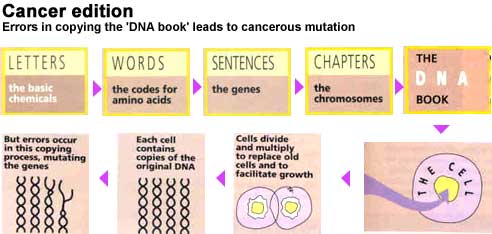Manipulating the basics
 How do you fix faulty genes that cause cellular havoc by sending out all the wrong signals? Using molecular genetic techniques, scientists are trying to insert bits of foreign DNA into cancerous cells to correct them. But the problem is: how do you do it for every tumour cell?
How do you fix faulty genes that cause cellular havoc by sending out all the wrong signals? Using molecular genetic techniques, scientists are trying to insert bits of foreign DNA into cancerous cells to correct them. But the problem is: how do you do it for every tumour cell?
To incorporate foreign DNA, both physical methods and the use of vectors like altered viruses have been tried. But so far, success with physical methods has been limited and viruses tend to get knocked out by the body's immune system. Moreover, viral DNA is so tiny that it can incorporate only small bits of foreign DNA.
Several efforts are being made to manipulate the genes. To enhance the body's weak response to cancer cells, scientists are examining the possibility of incorporating into tumour cell genes that code for killer proteins like inter-leukin-2 and interferon. They hope that these altered tumour cells, when reinjected into the body, will elicit an enhanced immune response.
Other scientists are trying to insert these genes into cells that can home in on the tumour cells and release larger quantities of their toxins. However, researchers caution that these substances, usually produced in infinitesimal quantities in the human body, can have severe side-effects in larger doses.
Genetic manoeuvres are being tried to overcome the biggest limitation of chemotherapy: lack of specificity. The selectivity of chemotherapy could be enhanced if the drug could be made to react by certain genes that are found only in cancer cells. Already, several such genes have been identified, including a gene that codes for an enzyme that can convert a comparatively non-toxic anti-fungal drug into an extremely toxic drug. This system is being tried against breast cancer.
Other groups are trying to block the activity of abnormal oncogenes, which normally accelerate cell growth. It is possible to incorporate genes to correct this abnormality. This is known as antigene therapy. Similarly, efforts to enhance the normal effect of faulty tumour suppressor genes are also being made.
However, several risks of gene therapy have yet to be overcome. According to Karol Sikora of the Royal Postgraduate Medical School at London's Hammersmith Hospital, the biggest risk is what is known as insertional mutagenesis, where the insertion of foreign DNA into cells may lead to alterations in normal cells, making them cancerous. Moreover, viruses that are used to incorporate foreign DNA bits may take in other DNA, becoming dangerous environmental pollutants. The viruses may also stimulate toxic shock in a patient and there are risks that non-viral bits of genetic material could get incorporated into the human genome.
Given these risks, Sikora feels it is unrealistic to expect these new strategies to be effective immediately. The risks are low only for desperate patients, who will end up providing much information, but at little personal benefit.
